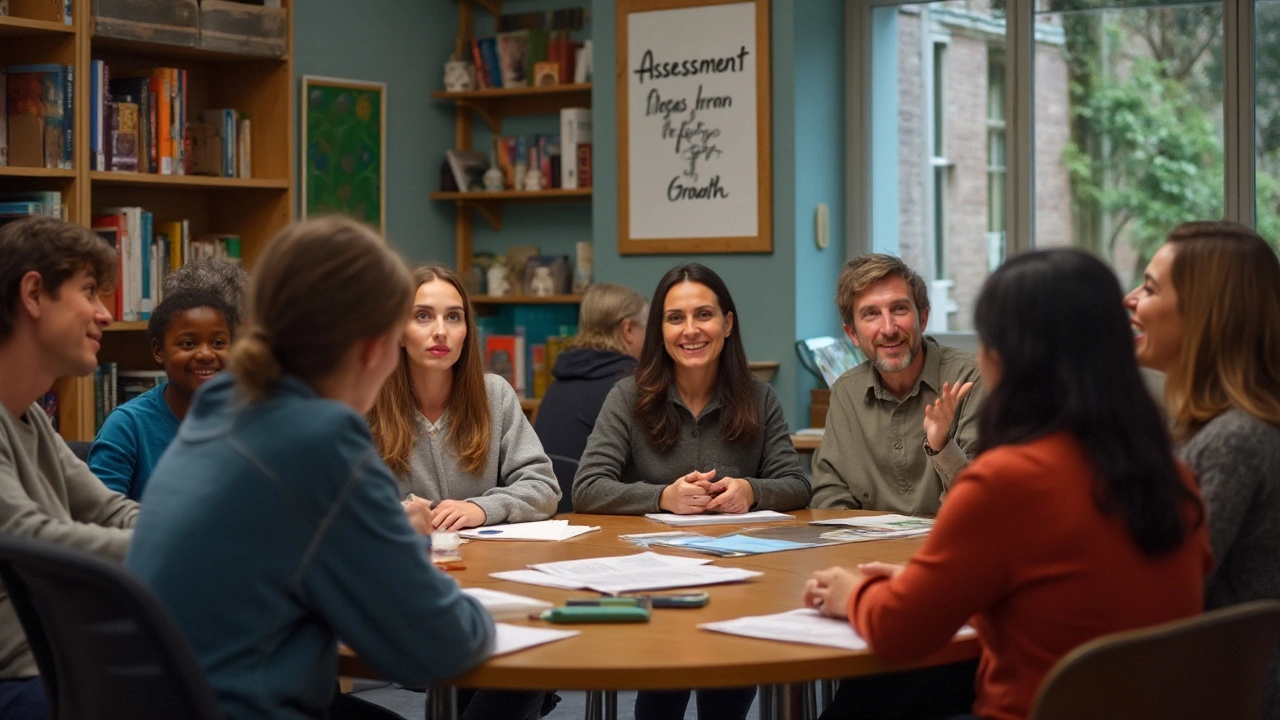Learning as an adult is an adventure of discovery and growth, tailored to the unique needs and aspirations one has developed over time. In this journey, the four A's of adult learning offer a framework that can guide and elevate the educational experience. They're not just concepts but tools to enhance how we engage with new information and skills.
Let's embark on an exploration of these four A's—each as important as the other in crafting an environment where adult learners can truly thrive. With the right mix of assessment, accessibility, application, and adaptation, learning becomes an adventure rather than a task.
Assessment
Assessment is the cornerstone of effective adult learning, serving as the roadmap to guide educational experiences towards meaningful goals. It's about understanding where the learner is starting from and what they hope to achieve. The role of assessment in adult education is to determine not only what learners know but also what they need to learn, and how best this can be accomplished. This process is critical because adults often return to learning with a rich bank of experiences, professional skills, and personal aspirations that should be factored into their education plan.
One significant aspect of assessment involves identifying prior knowledge and existing competencies. Adult learners come from diverse backgrounds and bring with them a range of previous life experiences. These can include work-related skills, informal education, or self-taught expertise. Recognizing and validating these existing skills can boost confidence and motivation. According to the National Center for Education Statistics, approximately 60% of adult learners have prior college credits or equivalency endorsements, highlighting the importance of personalized assessment in planning their educational paths.
Assessment methods vary and can range from traditional testing to more qualitative measures like interviews, surveys, or portfolio reviews. These methods help educators devise tailored learning strategies that effectively meet the unique needs of adults. The flexibility in assessment methods not only respects the learner’s background but also aligns with their learning styles and preferences. One of the advantages of leveraging varied assessment tools is that they can reveal unseen potential or unrecognized skills, which can then be harnessed for learning success.
Feedback is another integral part of the assessment process in adult education. It should be continuous and constructive, allowing learners to understand their progress and areas needing improvement. Constructive feedback fosters a positive learning environment, enabling learners to see mistakes as learning opportunities. According to Malcolm Knowles, a pioneer in adult education theory, "Feedback is the breakfast of champions"—highlighting its critical role in the learning process. Quick and ongoing feedback allows learners to adjust their learning strategies and keeps them engaged throughout the educational journey.
An effective assessment also sets the stage for setting realistic goals and milestones, providing a sense of direction and purpose for adult learners. By outlining clear objectives at the outset, educators and learners can collaboratively develop action plans that align with the learners’ professional and personal aspirations. Such goal-setting is vital, especially for adults balancing learning with work, family, or other commitments. This anchored sense of purpose inspires perseverance and dedication, enabling learners to navigate challenges more effectively.
Lastly, technology has revolutionized assessment in adult education, offering sophisticated tools for evaluating learning outcomes. Digital assessments can provide immediate feedback, track progress over time, and offer adaptive learning paths tailored to individual needs. Such innovations ensure that education methods keep pace with the changing demands of adult learners, making learning more accessible and relevant. In recent years, online learning platforms have incorporated AI-driven assessment tools that personalize educational experiences, standing testament to the evolving landscape of adult education.

Accessibility
In the realm of adult learning, the concept of accessibility stretches beyond simple entry points into education. It encompasses the entire spectrum of how learning materials and environments are designed to accommodate learners of all backgrounds and abilities. The digital age has rapidly expanded the ways educators can provide access, but the challenge remains to ensure no one is left out. Accessibility means creating courses and materials that are easily understandable and usable for everyone, regardless of physical or intellectual challenges. Accessibility is not just about legal compliance; it's about creating an inclusive learning environment where all students can achieve their potential.
The importance of accessibility becomes evident in its economic implications as well. By creating accessible learning options, educational institutions can reach a broader audience, thus increasing their enrollment numbers and potential revenue. Moreover, with the advancement of assistive technologies—like screen readers and voice recognition software—learners who might have been excluded in the past due to disabilities can now participate fully. It's a transformative shift that not only benefits individuals but enriches society by diversifying its workforce.
According to the National Center for Education Statistics, approximately 19% of undergraduate students in the U.S. reported having a disability. Accessibility opens learning pathways for these individuals, promoting equality in educational opportunities.
Moreover, accessibility involves various modalities of adult learning. Blended learning models, which integrate online digital media with traditional face-to-face methods, offer learners flexibility without losing the personal interaction that in-person classes provide. This blend can be a bridge for those who cannot attend regular classes due to geographical or time constraints. Besides that, the use of websites with adjustable fonts, carefully tested colors, and clear navigation enhances user experience, making digital learning environments intuitive and engaging.
A key factor in maintaining accessibility is ongoing feedback. Institutions should implement systematic methods of gathering input from students to continuously improve their courses and make them more accessible. Surveys and feedback forms can reveal the specific needs of students, allowing institutions to adjust curriculums and resources accordingly. By prioritizing student feedback, institutions not only improve their programs but also build a strong reputation for valuing diversity and inclusion.
Accessibility also intersects with affordability. The two often go hand in hand—as making learning accessible in multiple formats can also mean reducing costs. For instance, open educational resources (OERs) provide cost-effective solutions for learners while ensuring a wide range of materials are available. These resources are freely accessible and openly licensed educational materials that can be used for teaching, learning, and research, leveling the educational playing field.
Building an accessible learning environment requires a multifaceted approach, a commitment from institutions to adapt and modify their traditional methods, and the active involvement of educators who understand and uphold the principles of universal design for learning (UDL). This principle encourages a flexible approach to curriculum design that caters to a wide array of learning differences and needs. With the right infrastructure and commitment, adult education can be a tool for empowerment across diverse populations.

Application
Application is the heart of adult learning, where theoretical concepts are transformed into practical skills and real-world knowledge. Adult learners thrive on being able to see how what they learn applies to their everyday lives, their jobs, and the world around them. This makes application not just a phase in the learning process, but a constant horizon that guides the journey itself. For adults, applying knowledge serves as proof of understanding and mastery, and it is often where the deepest levels of learning occur.
Take, for instance, how problem-based learning engages adults by encouraging them to tackle real-world scenarios. This method not only solidifies understanding but also promotes critical thinking and innovation. It is in this hands-on learning environment that adults are able to bridge the gap between theory and practice, which is fundamental for personal or career growth. According to a survey by the Association of Talent Development, over 80% of adults report learning more effectively by doing, reinforcing the value of the 'learn by doing' approach.
Beyond workplace scenarios, application plays a critical role in personal growth and lifelong learning as well. Activities such as volunteering, starting a side hustle, or even experimenting with new hobbies are all rich grounds for applying new skills. This experiential learning bolsters confidence and adaptability, enabling individuals to navigate the complexities of today's rapidly changing world.
To foster this, educators and trainers should strive to create learning experiences that mimic real-world challenges. Utilizing role plays, case studies, and simulations can significantly enrich the learning process. These immersive experiences not only anchor the learning material but also prepare adults to handle similar situations in their daily lives, thereby enhancing the relevance and retention of knowledge.
An instructive example comes from the medical field, where simulations have become a cornerstone of training. By working through lifelike scenarios, medical students and professionals can better prepare for the unpredictable nature of healthcare, where lives often depend on quick thinking and precise application. As Albert Einstein once said, “The only source of knowledge is experience.” By creating opportunities for application, we're tapping into the incredible potential that adult learners possess.

Adaptation
Adaptation in adult learning refers to the ability of both the learner and the educator to adjust and thrive within a dynamic learning environment. It's more than a buzzword; it's an essential process that ensures the educational journey is relevant and effective. In the fast-paced world we live in, information is constantly evolving, and thus, what we learn must be able to change and grow with the times. Unlike traditional education systems focused on rote learning and fixed curricula, adult learning emphasizes a fluid structure that can flex and pivot as required by the learner's needs and industry demands.
Adults bring to their learning processes numerous experiences, and they often have clear goals and expectations. This distinguishes adult learning from other forms of education. To truly meet the changing needs of the adult learner, adaptation involves personalizing learning experiences to fit diverse backgrounds and learning styles. Strategies like blended learning, which combines face-to-face instruction with online resources, highlight this adaptive quality. They not only help maintain the engagement of adult learners by accommodating various learning preferences but also encourage them to take control of their own intellectual growth.
"Adaptation is not about abandoning all structure but about creating a learning ecosystem where change is embraced as an opportunity for further development." - Jack Mezirow, Transformative Learning Expert
Another crucial aspect of adaptation in education methods is the integration of technologies. With the rise of digital tools, providing learners with the skills to successfully navigate online platforms and resources has become pertinent. Educators leveraging digital advancements must also ensure that these technologies serve to enhance, rather than replace, critical thinking and problem-solving skills. Adaptation means seeing technology as a tool for bridging gaps in learning, not as a solution in itself.
Implementing Adaptive Strategies
Effective adaptation often follows structured yet flexible strategies that allow for seamless integration of new materials and concepts. A practical approach can begin with regularly assessing the efficacy of your educational strategies. Feedback from learners, in turn, provides invaluable insights. This creates a loop of continuous improvement, where the learning experience is consistently refined. Encouraging engagement and fostering a culture of feedback require openness from both educators and learners.
Adaptation is especially critical when considering the potential of lifelong learning. As industries evolve, skills that were once in high demand can quickly become obsolete. Adults must remain flexible and proactive, seeking to acquire new competencies well into their professional lives. Supporting such ambition means educational models themselves need to be adaptable, offering pathways that accommodate the changing landscapes of work environments.

